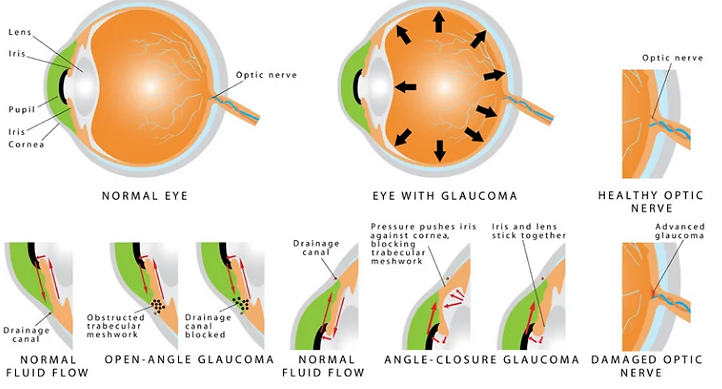Glaucoma is the most serious eyesight-threatening condition. It usually manifests as a painless, gradual loss of vision. The lost vision can never be recovered. However, medical or surgical treatment can prevent or retard further loss of vision.
Do Not Confuse Glaucoma with a Cataract
Many times it can be confused with a cataract which also manifests as a painless, gradual loss of vision. The difference is that in the case of cataract, the loss of vision is fully recoverable using a simple surgery called Phaco.
Our eyes contain a clear fluid called aqueous humor, which is continuously produced in the eye to bath and nourish the structures inside it. The fluid normally drains out of the eye through drainage canals in a fine meshwork located around the edge of the iris (the colored part of the eye that surrounds the pupil). In people with glaucoma, the fluid fails to drain due to some defect and thus increases the pressure inside the eyes called raised Intraocular Pressure (IOP) (or Tension).
Who is at a Risk for Glaucoma?
Anyone can develop glaucoma. Some people are at higher risk than others. They include:
-
Everyone over the age of 40 yrs.
-
People with family history of glaucoma.
-
Diabetics
-
People with near sightedness (Myopia) for open angle type and far sightedness (hyperopia) for close angle type
-
People with Hypertension
-
People with Migraines
Common Symptoms of Glaucoma
In most cases of glaucoma, the patient is not aware of the gradual loss of sight until vision is significantly impaired. However, if glaucoma progresses without adequate treatment, the following symptoms may occur in some individuals:
-
Pain around the eyes when coming out from darkness (e.g., as soon as the person comes out of a cinema hall)
-
Colored halo rings seen around light bulbs especially in the mornings and nights
-
Frequent change of reading glasses, headaches, pain, and redness of the eyes
-
Reduced vision in dim illumination and during nights
-
Gradual decrease of side vision with the progression of glaucoma
Types of Glaucoma

_edited.png)







